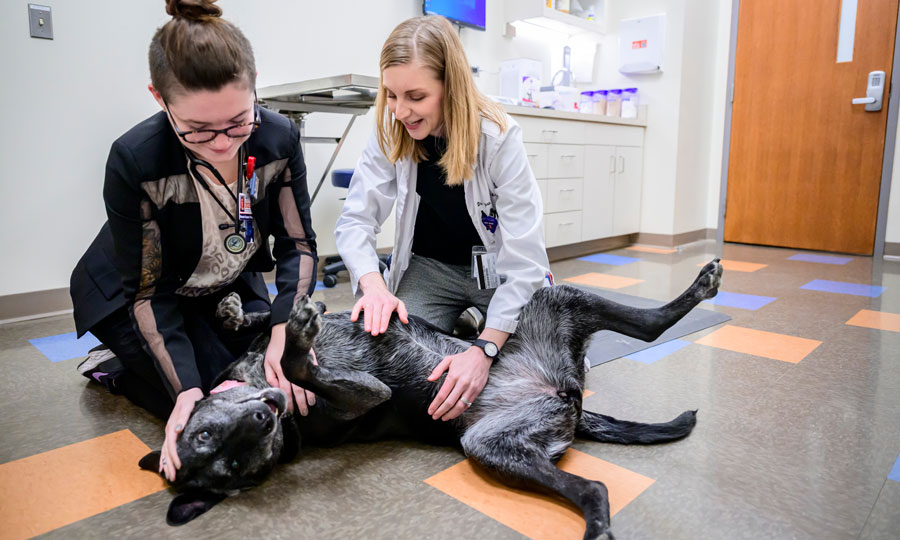Pet’s cancer may be managed vs. cured
The word “chemotherapy” conjures up images of nauseous, balding, and debilitated patients. While supportive therapies are available to soften these side effects in human cancer patients, it’s true that medical doctors often treat cancer very aggressively, hoping to achieve complete remission of disease.
For patients undergoing chemotherapy at the University of Illinois Veterinary Teaching Hospital in Urbana, however, the way that risks and benefits of treatment are considered is different than for human patients, explains veterinary oncologist Dr. Kimberly Selting. Pets with cancer are closely monitored throughout their treatment to ensure a good quality of life. Certainly the hope is always to have as much time and as normal a life span as possible, but quality comes first.
“Pets are shorter-lived than people, and accordingly diseases tend to progress more rapidly,” says Dr. Selting. “When we prescribe chemotherapy, we are trying to delay or prevent growth of cancer throughout the body, not necessarily to completely eliminate it.”
Side Effects of Chemotherapy in Pets
In general, pets do not experience the acute nausea and other side effects that humans do in large part because veterinarians are pursuing different treatment goals for their patients.
“When it comes to gastrointestinal side effects, I use a ‘rule of three’,” says Dr. Selting. “If a pet is vomiting or has diarrhea that occurs more than three times in a day or lasts more than three days, it is time to contact your veterinarian to reevaluate the plan. Unpleasant side effects should be transient. If they are not, we can offer an alternative care plan to help. And mild side effects can be treated so that they don’t occur altogether.”
Another common side effect of chemotherapy is interference with bone marrow function. Chemotherapy targets rapidly dividing cells, which mean that healthy cells that are rapidly dividing, such as those in bone marrow, will be damaged along with the cancer cells. This situation can leave the patient’s immune system vulnerable to infection.
“We monitor patients’ clinical signs to assess their comfort, and we calculate dosages of chemotherapy to keep the risk of side effects low while optimizing efficacy,” says Dr. Selting.
Most pets do not experience the hair loss so characteristic of human chemotherapy, with the exception of some breeds, including poodles, Maltese, and some terriers, that have continuous-growing coats. Cats may lose their whiskers, but not to worry. Cats can function just fine without them, and the whiskers can grow back.
Treatment Tailored to the Patient
“Cancer treatment is very individualized and tailored to the patient. Every case is different. When we are faced with a cancer diagnosis and the pet owners choose to pursue treatment, we take into consideration the individual needs and goals of this family. There is a large communication aspect to what we do.”
Certain cancers, including lymphoma, respond well to chemotherapy, consistently giving pets improved quality, and even length, of life. However, not all cancers are treatable with chemotherapy. Your veterinarian will advise you on the options and expected outcomes with and without therapy.
Besides chemotherapy, cancer treatment approaches include surgical removal of the cancer, radiation therapy that attacks the cancer locally, targeted therapies that interrupt the cancer cell’s signaling pathways to prevent cell division, and immunotherapy, which has ancient origins and is once again a developing area of research. The basis of immunotherapy is to teach the body’s own immune defenses to notice and attack the cancer cells.
In discussing treatment options and expected outcomes with pet owners, veterinary oncologists point to data on median life spans of other animals that have undergone this treatment for the same type of cancer.
Living with Cancer
“We share this data to compare options, but there is no way to guarantee how long your pet is going to live,” Dr. Selting says. “Added life span with treatment depends on many different factors.”
Although she knows that a cancer diagnosis can be devastating, Dr. Selting says her 15 years of experience treating pets with cancer has been intellectually stimulating and emotionally rewarding.
“We see patients that live a long time and die of other causes, even when the cancer is never completely gone,” she says. “If you look at cancer as a chronic disease, many are manageable, and some can be controlled for the pet’s natural life span. Many varieties of cancers have a good prognosis with treatment, and we are able to provide pets and their families quite good qualities of life.”
If you have questions about chemotherapy or cancer treatment, contact your local veterinarian.
By Hannah Beers
Photo of Dr. Selting and her dog Spike, a beagle-Kerry blue terrier mix, by L. Brian Stauffer.

![[Dr. Kimbery Selting with Spike]](https://vetmed.illinois.edu/wp-content/uploads/2021/04/pc-chemo-selting.jpg)


